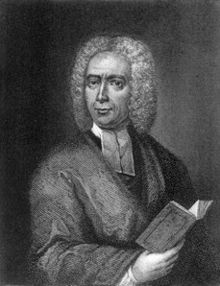
A hymn is a type of song, and partially synonymous with devotional song, specifically written for the purpose of adoration or prayer, and typically addressed to a deity or deities, or to a prominent figure or personification. The word hymn derives from Greek ὕμνος (hymnos), which means "a song of praise". A writer of hymns is known as a hymnist. The singing or composition of hymns is called hymnody. Collections of hymns are known as hymnals or hymn books. Hymns may or may not include instrumental accompaniment. Polyhymnia is the Greco/Roman goddess of hymns.

A hymnal or hymnary is a collection of hymns, usually in the form of a book, called a hymnbook. They are used in congregational singing. A hymnal may contain only hymn texts ; written melodies are extra, and more recently harmony parts have also been provided.

The hymn "When I Survey the Wondrous Cross" was written by Isaac Watts, and published in Hymns and Spiritual Songs in 1707. It is significant for being an innovative departure from the early English hymn style of only using paraphrased biblical texts, although the first couplet of the second verse paraphrases Galatians 6:14a and the second couplet of the fourth verse paraphrases Gal. 6:14b. The poetry of "When I survey…" may be seen as English literary baroque.

Isaac Watts was an English Congregational minister, hymn writer, theologian, and logician. He was a prolific and popular hymn writer and is credited with some 750 hymns. His works include "When I Survey the Wondrous Cross", "Joy to the World", and "Our God, Our Help in Ages Past". He is recognised as the "Godfather of English Hymnody"; many of his hymns remain in use today and have been translated into numerous languages.

"Love Divine, All Loves Excelling" is a Christian hymn by Charles Wesley on Christian perfection. Judging by general repute, it is among Wesley's finest. Judging by its distribution, it is also among his most successful.
"Joy to the World" is an English Christmas carol. It was written in 1719 by the English minister and hymnwriter Isaac Watts, and its lyrics are a Christian reinterpretation of Psalm 98 and Genesis 3. The carol is usually sung to an 1848 arrangement by the American composer Lowell Mason.
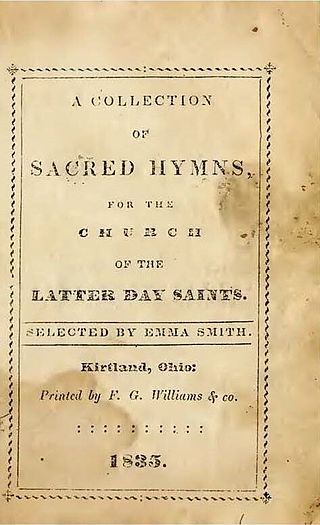
A Collection of Sacred Hymns, for the Church of the Latter Day Saints. was the first hymnal of the Latter Day Saint movement. It was published in 1835 by the Church of the Latter Day Saints.
Worm theology is the idea in Christian culture that in light of God's holiness and power an appropriate emotion is a low view of self. The name may be attributed to a line in the Isaac Watts hymn Alas! and Did My Saviour Bleed which says "Would he devote that sacred head for such a worm as I?" This thinking was prevalent in the days when this hymn was originally written, perhaps because there was also a higher view of God. Furthermore, worm theology can be attributed to a recognition of the ugliness of sin, resulting in contrition.
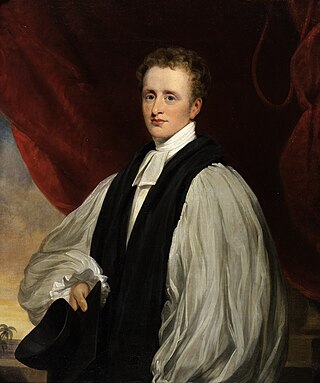
"Holy, Holy, Holy! Lord God Almighty!" is a Christian hymn written by the Anglican bishop Reginald Heber (1783–1826).
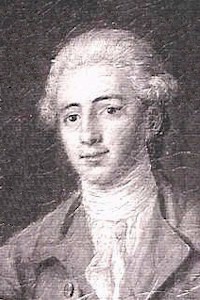
"All Hail the Power of Jesus' Name" is a Christian hymn.
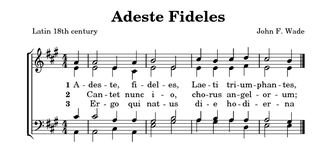
A hymn tune is the melody of a musical composition to which a hymn text is sung. Musically speaking, a hymn is generally understood to have four-part harmony, a fast harmonic rhythm, with or without refrain or chorus.
Hymnology is the scholarly study of religious song, or the hymn, in its many aspects, with particular focus on choral and congregational song. It may be more or less clearly distinguished from hymnody, the creation and practice of such song. Hymnologists, such as Erik Routley, may study the history and origins of hymns and of traditions of sung worship, the biographies of the women and men who have written hymns that have passed into choral or congregational use, the interrelationships between text and tune, the historical processes, both folk and redactional, that have changed hymn texts and hymn tunes over time, and the sociopolitical, theological and aesthetic arguments concerning various styles of sung worship.
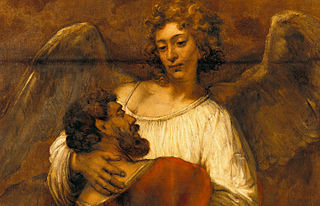
"Wrestling Jacob", also known by its incipit, "Come, O thou Traveller unknown", is a Christian hymn written by Methodist hymn writer Charles Wesley. It is based on the biblical account of Jacob wrestling with an angel, from Genesis 32:24-32, with Wesley interpreting this as an analogy for Christian conversion. First published in 1742, it has been included in every Methodist hymnbook since 1780. In its original form, it had fourteen stanzas, but it is rarely sung in its entirety. The hymn is commonly described as one of Charles Wesley's greatest compositions, with the hymn writer Isaac Watts quoted as saying that "that single poem, Wrestling Jacob, was worth all the verses he himself had written".

"Praise, my soul, the King of heaven" is a Christian hymn. Its text, which draws from Psalm 103, was written by Anglican divine Henry Francis Lyte. First published in 1834, it endures in modern hymnals to a setting written by John Goss in 1868, and remains one of the most popular hymns in English-speaking denominations.
"Jesus Christus, unser Heiland, der von uns den Gotteszorn wandt" is a Lutheran hymn in ten stanzas by Martin Luther for communion, first published in 1524 in the Erfurt Enchiridion. It is one of Luther's hymns which he wrote to strengthen his concepts of reformation. The models for the text and the melody of Luther's hymn existed in early 15th-century Bohemia. The text of the earlier hymn, "Jesus Christus nostra salus", goes back to the late 14th century. That hymn was embedded in a Hussite tradition.
"At the Name of Jesus" is a hymn with lyrics written by Caroline Maria Noel. It was first published in 1870, in an expanded version of Noel's collection The Name of Jesus and Other Verses for the Sick and Lonely. At the time, Noel herself experienced chronic illness, which persisted until her death. The hymn has become popular across Christian denominations, and appears in over 200 hymnals. It has been set to a few different tunes, including compositions by William Henry Monk, Ralph Vaughan Williams and Michael Brierley.
"Christians, awake, salute the happy morn" is an English Christmas hymn on a text by John Byrom. It is usually sung to the tune "Yorkshire" by John Wainright.

"A Charge to Keep I Have" is a hymn written by Charles Wesley. It was first published in 1762 in Wesley's Short Hymns on Select Passages of the Holy Scriptures. The words are based on Leviticus 8:35. It is most commonly sung to the hymn tune Boylston by Lowell Mason.
Ralph Erskine Hudson was an American composer and hymnwriter. He is best remembered for his hymn "My Life, My Love, I Give to Thee" and his addition of a refrain and composition of a new tune for the Isaac Watts hymn "Alas! and Did My Saviour Bleed".
David W. Music is an American composer, writer and former professor of church music. He served on the faculties of both his alma maters, California Baptist College and the Southwestern Baptist Theological Seminary, before spending 18 years at Baylor University. His publications have included edited collections of primary sources, monographs on the history of American hymnody, and works on the hymnwriter Isaac Watts. He has also composed works for choirs, recorder, organ and piano. In 2010, he was named a Fellow of the Hymn Society in the United States and Canada.
